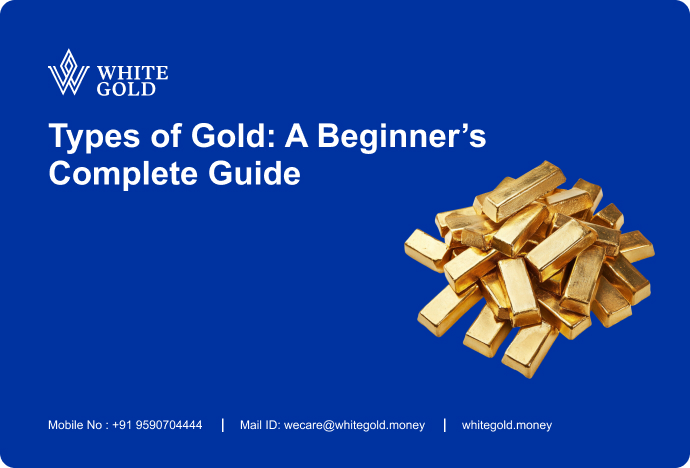How to Understand the Expected Gold Rate in 2030 in India

5min read

Who knows what gold would be priced at in 2030? And if you are one who holds dear to it, be it for investment purposes or personal usage, then knowing where the price of gold is headed changes the game. Tradition has been the surest investor in gold, especially in India, where it has meant more than just a metal-it is tradition. How would the gold rate change in 2030? Global economies and technological changes may still continue; however, the love for gold in India will not change. It is crucial to get a real picture of what might propel the future prices before one steps toward the year 2030. Here are the foremost factors that can shape the gold rate in India toward 2030.
Want to get the best rate when selling your gold? Visit your nearest White Gold branch today and enjoy a world-class gold selling experience from their highly professional staff.
Historical Gold Rate Trends in India
To understand the future, it’s very much needed to look back at the past. Gold rate in India has seen drastic shifts over the years that have been brought about by global as well as international factors. Starting from the economic crises which the world went through in the 1990s to the recent impacts of the COVID-19 pandemic, every single event has its direct impact on the gold valuation. Historically, it had been during periods of economic uncertainty that people invested more in gold, therefore the gold rate.
There is also a big demand in which Indian gold buyers have been making high demands during festivals such as Diwali or Akshaya Tritiya. More importantly, for most of the people, investing in gold is not where they place their money; it is a means of protection. The people who opt to sell their gold when they feel that they need private financial support or when it reaches the top it creates dynamic supply and demand cycles.
By studying these past patterns, we can begin to understand how future economic and social factors might affect the gold rate in 2030.
Global Economic Factors Impacting Gold Prices
In India, the gold price, other than being susceptible to local demand, is very much related to international economic parameters. The first parameter in this list, of course, would be inflation. Essentially, whenever inflation increases in a country, the general value of currencies starts falling drastically, causing investors to look for greener pastures such as safe investments in gold. This increases the demand for gold globally, thus hiking up its price. In such circumstances, many foreign and Indian gold investment people come out to buy gold as a hedge against financial instability.
Another thing is the strength of the dollar. As this is a commonly traded commodity in dollars, any falling or rising rate of the dollar naturally impacts the rate of gold. A weak dollar normally means a higher price of gold. At such times, it would be wise for investors to sell gold. Furthermore, with increased tensions between countries, or some global tragedy, the demand for gold increases because this asset will always provide refuge in uncertain situations.
Also, monitoring global trends would help to improve the forecast about how the value of gold would behave up to 2030, taking all aspects such as inflation, fluctuation in currency, and geopolitics into consideration. All this knowledge assists both gold buying and selling parties to take informed decisions.
Domestic Influences on Gold Rates in India
Gold in India has a history dating back thousands of years, and this historical alliance of gold plays a great role in the determination of the gold rate inside the country. In fact, its biggest demand comes from gold jewelry during wedding seasons and festivals. This ensures that Indian gold buyers are active all throughout the year, thereby propelling up the demand and shooting up the prices of gold. In addition, during these crucial periods, there are surges in demand that shoot up gold prices by leaps and bounds.
Government policies also significantly affect the gold rate. Import duties on gold, as well as taxes on purchases, directly influence how much consumers pay. For example, any increase in import duties makes it more expensive to purchase gold in India, driving prices up. In such instances, individuals looking to sell gold can benefit from higher rates. On the flip side, favorable government policies or tax reductions can make gold more affordable, attracting more buyers into the market.
Another key area of consideration is the economic outlook of India. If the economy of India is uncertain or inflationary, Indian consumers will often want gold as a safe investment that hikes up the prices. Whether you are looking to buy at a time when you have planned an investment or, in fact, want to sell your gold, being aware of the country-specific factors helps you bet on the right future expectations of the gold rates in India.
Technological and Market Innovations Shaping Future Gold Prices
As we approach 2030, the gold rate in India will not only be shaped by traditional factors but also by emerging technologies and market innovations. One of the most notable shifts is the rise of digital gold investments. Platforms now allow gold buyers to purchase and hold gold electronically, offering a more convenient and secure way to invest. This digital transformation is making gold more accessible to a wider audience, increasing demand and potentially driving prices higher.
Another game-changer is blockchain technology, which brings in transparency and security in the process of gold trading. It ensures source authenticity of gold at all levels, appealing to the new generation of tech-savvy investors. This might impact how both physical and digital gold is traded and, thus, affect the rate of gold as trust in the market grows.
On the supply side, advancements in mining technology could influence the availability of gold. If extraction methods become more efficient, it could stabilize or lower prices. However, if supply remains limited and demand continues to rise, especially as more people choose to sell gold through new-age platforms, prices could increase.
Conclusion
Predicting the gold rate in India in the coming years is going to be a mix of much more than guesswork and more of knowing how complexly factors shape the market. It goes from the history and changes in the world’s economies to local influences and the boon of technology in the price of gold.
Such changes will really work to the advantage of a gold buyer who can now make wiser decisions about smart investment decisions. And if there are plans to sell gold, then knowing when prices may top out will better ensure getting the best money for your assets. Of course, nobody knows for sure what tomorrow will bring, but knowledge of the factors driving gold prices puts one in a much better place to navigate the landscape of gold in India and position oneself better.
Planning on selling gold? Or getting a gold loan quickly? Call White Gold today at +91 9590704444 and get the best value for your gold transferred directly to your bank account.







